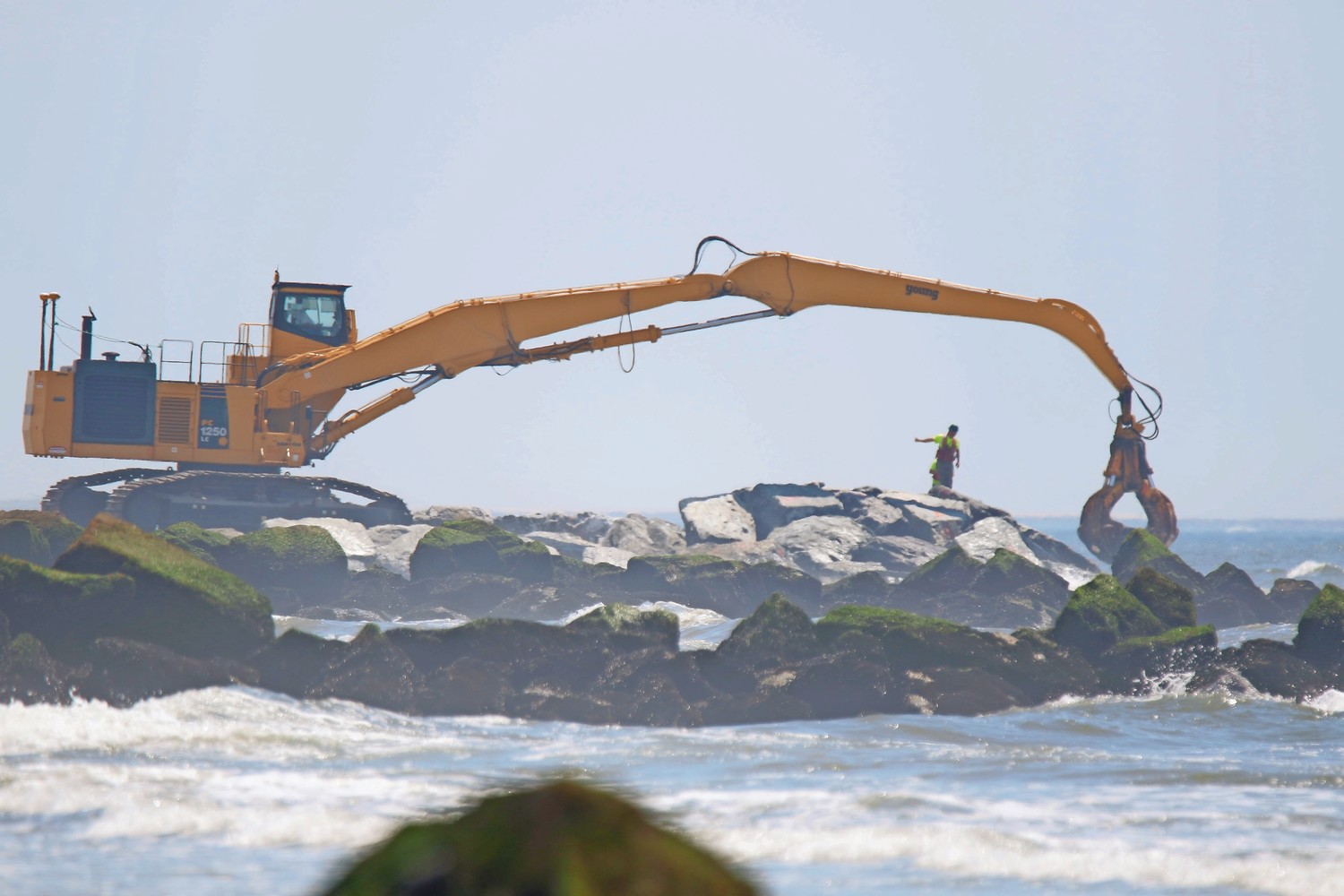Army Corps completes work on Long Beach jetties
$230 million coastal protection project moving on to dune work
A year after the Army Corps of Engineers began work on a $230 million coastal protection project in Long Beach in the wake of Hurricane Sandy, the agency recently completed the reconstruction of 15 jetties, or groins, along the beach and will now move on to building dunes and replenishing sand.
The berm, dune and groin system is designed to protect seven of the nine miles of public shoreline between Jones Inlet and East Rockaway Inlet — from the east end of Point Lookout to Nevada Avenue in Long Beach — from a 100-year storm. The project began in Point Lookout in 2016.
In September, H&L Construction, the contractor overseeing the project, completed work on eight of the groins, which trap sand and protect the beach from erosion — two more than originally planned. Two were under construction at a time, and took about a month to complete.
Army Corps officials had said that that work was ahead of schedule, and it capped a busy summer season in which officials and residents had expressed concerns about the project’s impact on the city’s businesses and quality of life.
The remaining jetties have been completed since then, and the agency said it expects to award a contract for the next phase of the project next month, after bids were submitted for sand replenishment and dune crossovers along the boardwalk.
“They’ll be adding about 1,000 feet [of sand] a week [on the beach] and keep moving from east to west. It’s a 24/7 operation,” said John Mirando, the city’s public works commissioner. “We prefer that they start in September, and it looks like they won’t be able to start this summer.”
The Army Corps and state Department of Environmental Conservation are expected to hold a public meeting at Long Beach City Hall on April 18 at 7 p.m., and another in Point Lookout on April 19, to update residents about the next phase of the project.
“We’re awarding the contract next month for sand and dune crossovers, and as soon as that contract is awarded, we’ll know a little bit more about when work is going to start,” said Army Corps spokesman Michael Embrich.
The next phase of the project is expected to take about 18 months to complete, Mirando said. The plan calls for 25-foot-wide dunes that will run parallel to the boardwalk and rise to a height of 14 feet nearest the boardwalk. They will slope down to a 40-foot-wide berm at an elevation of nine feet, and a 130-foot-wide berm two feet lower that will slope down to the waterline. The project includes 33 dune crossovers in Long Beach alone, and the dunes would connect with those already in place at Nickerson Beach and in the city’s West End.
Sandy decimated the city’s shoreline — the beach lost 294,000 cubic yards of sand — and officials contend that the project is crucial. Mirando said that sand will be pumped from an offshore barge, and the replenishment will involves payloaders and other vehicles on the beach. Once the project is completed, if another storm were to damage the beach, the city would also be eligible for federal emergency rehabilitation funding to replace the sand.
City officials expressed concerns last year about the project’s impact on the busy beach season, which included partial beach closures. The city persuaded the agency to work on the groins at or near the staging areas, at New York Avenue and Neptune Boulevard, after Memorial Day to avoid hauling rocks across the beach and minimize the impact on the summer season.
Mirando said that while construction of the jetties has been completed, workers are removing leftover rocks and cleaning the beach. He added that a sea wall at Neptune Boulevard, which was removed to enable trucks to deliver large stones, is being replaced. Embrich said that the corps is currently working on a groin in Point Lookout that should be complete this summer.
“The biggest thing we’re going to be concerned about is that the sand grain is the right size — there may be a little discoloration when the sand is first placed,” Mirando said.
The corps plans to use sand dredged from a mile off Long Beach, agency officials said, and the new sand will be “comparable” to the existing beach. Fourteen of the crossovers will run along the boardwalk, Mirando said, and work on the piles for those structures could start this summer.
“They may build [the crossovers] ahead of the dunes. It depends on when the sand replenishment starts,” Mirando said.
Morris Kramer, an environmental activist who said he pushed for the project for three decades, criticized the work on the jetties, saying that they were built “too short,” and that water during strong tides is circumventing the rock structures and causing erosion during major storms.
“It sort of sabotages the whole dune program,” Kramer said. “When you get a real storm, that part of the beach is already eroded, and it could erode more of the sand. When that sand gets washed out, it’s weak.”
Mirando said that the new jetties are longer than the original ones, and as a result, the ends were rebuilt without foundations.
“This has resulted in the seaward ends sinking from the wave action,” Mirando said, adding that the corps believes that once the second phase of the project is completed, that would no longer be an issue. “You have 30,000-pound stones on the end of the groin, and as a result of the wave action, they sink. We brought in our own consultant to do an evaluation. Our feeling was it could be a design flaw . . . but [the Army Corps] feels that, once the sand is replenished, it’s not going to be an issue.”

 50.0°,
Overcast
50.0°,
Overcast 




